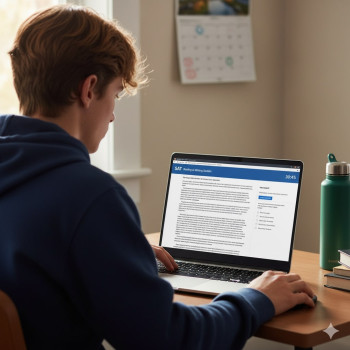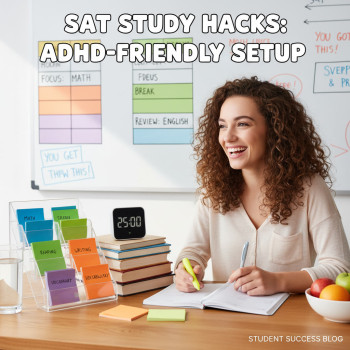Why a study plan matters when you’re homeschooled
Being homeschooled gives you flexibility, freedom, and the ability to learn at your own pace. But that freedom can also be a double-edged sword when it comes to a high-stakes exam like the SAT. Without the structure of a classroom, it’s easy to either overdo it (burnout) or underprepare (last-minute cramming). A thoughtfully built study plan turns homeschooling’s greatest advantage — personalization — into a strategic edge.
Think of a study plan as your GPS. You still choose the destination, but a clear route with checkpoints makes the trip smoother. This guide walks you through building that route: assessing where you are, deciding how much time you need, picking the right materials, and keeping momentum. I’ll also share practical examples and a sample weekly schedule you can adapt. And where one-on-one guidance fits best, I’ll mention how Sparkl’s personalized tutoring and tailored study plans can plug into your journey without ever feeling like a rigid template.
Start with an honest assessment
Take a diagnostic test
The first action is simple: take a full-length, timed diagnostic SAT. Treat it like the real thing. Don’t peek at answers as you go. The diagnostic serves two purposes: it identifies strengths and weaknesses, and it gives you a baseline score to measure progress against.
After the test, break your results down by section (Reading, Writing & Language, Math — calculator and no-calculator) and by question type (e.g., passage-based evidence questions, algebraic problem solving, grammar in context). That level of detail reveals whether you need broad review or focused drilling.
Reflect on learning habits and time availability
Diagnosis isn’t only about scores. Ask yourself these questions:
- How many hours per week can I realistically study without burning out?
- When am I most alert: mornings, afternoons, or evenings?
- Do I prefer short daily sessions or longer sessions a few times a week?
- Are there specific commitments (sports, family responsibilities, college classes) to work around?
Being honest here keeps your plan realistic. If you schedule four hours every weekday but only actually have two, the mismatch will kill momentum.
Set a target and work backward
Once you have a baseline, set a target score. Make it ambitious but achievable. If you scored a 1100 and want 1350, that’s a realistic goal within 3–6 months depending on how much time you can commit. Working backward means mapping how many practice tests, content review sessions, and targeted drills you’ll need weekly to reach that improvement.
Example: small, consistent gains look like +10–20 points per week in a weak area. Bigger jumps usually involve both strategy shifts and increased practice tests under timed conditions.
Choose a study rhythm: weekly and daily frameworks
Weekly structure
Your weekly plan is the skeleton. A balanced approach combines focused content review, strategy practice, and full-length tests. Here’s a flexible template you can adapt:
- 3–4 focused content sessions (50–90 minutes each): deeply work on one section or skill.
- 1–2 mixed practice sessions (timed sections or problem sets): build endurance and transition skills between sections.
- 1 full-length practice test every 1–2 weeks (timed, under realistic conditions).
- Short daily warm-ups (15–25 minutes): vocab flashcards, mental math, or a quick reading passage.
Daily micro-schedule examples
Two common rhythms work well for homeschoolers:
- Daily short sessions: 5 days × 60–75 minutes — keeps momentum high and learning fresh.
- Block days: 3 days × 90–120 minutes — deeper immersion when you have big chunks of time.
Pick the one that fits your energy and commitments. If you’re juggling coursework or extracurriculars, shorter daily sessions often win because consistency matters more than duration.
Build a focused content plan
Prioritize by impact
All content doesn’t have equal return on investment. Prioritize topics that show up frequently on the SAT and where you can gain the most points quickly. For many students that looks like:
- Algebra (linear equations, systems): high frequency in Math.
- Problem solving and data analysis: use of ratios, percentages, and interpreting graphs.
- Sentence structure and punctuation rules: efficient gains in Writing & Language.
- Evidence-based reading: find and cite support quickly.
Focus on patterns. For example, many grammar errors on the SAT revolve around subject-verb agreement, verb tense consistency, pronoun clarity, and parallelism. Drill these patterns until you recognize them without thinking.
Mix review with active practice
Reading explanations is useful, but active practice—where you explain why choices are wrong or rewrite sentences yourself—cements learning. Use a two-step cycle: learn one concept, then do 10–20 mixed problems applying that concept. This “practice after study” approach accelerates retention.
Sample 8-week plan (adjust to your timeline)
Below is a compact 8-week framework that balances content, strategy, and testing. Scale it up or down depending on how many weeks you have.
| Week | Focus | Weekly Goals |
|---|---|---|
| 1 | Diagnostic review & basics | Analyze diagnostic, set target score, review fundamental algebra and grammar rules, 1 timed section |
| 2 | Reading strategies | Active passage practice, annotation skills, 1 full practice section |
| 3 | Math fundamentals | Linear equations, slope, systems, mixed problem sets |
| 4 | Writing & Language | Grammar drills, sentence improvement, practice passages |
| 5 | Targeted review | Plug weak spots revealed by practice tests, focused drills |
| 6 | Timed practice | Full-length practice test, timed section practice, pacing drills |
| 7 | Advanced strategies | Hard question strategies, guessing logic, calculator use review |
| 8 | Final polishing & rest | Light review, sleep optimization, one final practice test early in the week |
Practice tests: your most honest tutor
Nothing replicates the SAT better than full-length, timed practice tests. But how you use them matters more than how often you take them. Quality over quantity:
- Take a test under realistic conditions: timed, minimal interruptions, same scratch paper, same breaks.
- Score it honestly and then dissect every missed question. Don’t just tally your wrong answers — categorize them (knowledge gap vs. careless mistake vs. timing issue).
- Use practice tests as experiments. If you change a strategy (e.g., read the passage first vs. read questions first), test it and compare results statistically across a few tests.
For many homeschoolers, pacing practice tests every 1–2 weeks during the later stages of prep is ideal. Early on, use them less frequently but learn deeply from each one.
Study tools and materials
Pick materials that match your learning style. A textbook-heavy approach helps some students; others respond better to short, targeted drills and explanations.
- Official practice tests (from the test maker) are gold for realism.
- Problem sets and question banks are great for focused drills.
- Flashcards (physical or digital) are ideal for vocabulary, formulas, and grammar rules.
- Timed section practice builds stamina and pacing skills.
If you’re unsure which materials suit you, one-on-one guidance can speed selection and avoid wasted time. That’s where Sparkl’s personalized tutoring, with tailored study plans and expert tutors, can be helpful — they blend human insight with AI-driven insights to match materials to your needs without overwhelming you.
Study techniques that stick
Spaced repetition and active recall
Use spaced repetition for vocabulary and formulas: review new items the next day, then three days later, then a week later. Active recall—trying to retrieve information without looking at notes—sharpens memory more than passive review.
Interleaving
Instead of practicing only geometry for two hours, mix question types from different topics. Interleaving forces your brain to identify the problem type and select the right tool — exactly what the SAT demands.
Explain out loud
Teach a concept to an imaginary student or to a parent. Explaining steps out loud reveals gaps in understanding and consolidates learning in a friendly, low-pressure way.
Time management and test-day pacing
Pacing is its own skill. On math sections, learn the average time per question and use a checkpoint system: after 10–15 questions, glance at your time and decide whether to speed up or switch to educated guessing. For Reading, practice chunking passages into 5–6 minute blocks and answering targeted question clusters.
When you consistently time sections during practice, you build an internal clock — crucial for test day. Remember: it’s better to answer more questions correctly with steady pacing than to answer fewer questions perfectly but leave many blank.
Staying motivated and avoiding burnout
Homeschooled students benefit from autonomy, but that can make motivation fragile. A few practical tips:
- Set micro-goals with rewards: finish four practice sets and get a favorite treat.
- Track progress visually (score chart, calendar streaks). Seeing upward trends is energizing.
- Balance intense study with deliberate rest: a short walk, a hobby, or social time keeps mental energy high.
- Vary your environment: alternate between a cozy desk, a library corner, or a sunny patio to keep study fresh.
If you’re feeling stuck, a few sessions with a tutor can re-energize your plan. Sparkl’s personalized tutoring offers 1-on-1 guidance and tailored study plans so you can get back on track without wasting time on the wrong materials.
How to use a tutor (and when it’s worth it)
Tutoring is not an admission of failure — it’s an efficiency tool. Consider a tutor when:
- Your diagnostic shows plateaued scores despite consistent work.
- You’re wasting time on ineffective strategies or materials.
- You need accountability and structure during a busy season.
A good tutor helps you triage your study plan, offers feedback on problem-solving approaches, and customizes practice. If you choose to work with a tutoring service, seek tutors who can tailor lessons to your homeschooling rhythm — offering flexible scheduling and a plan that complements schoolwork. Sparkl’s expert tutors and AI-driven insights can craft that balance, combining human coaching with data-backed suggestions to refine your approach.
Practical examples and mini case studies
Case 1: Maya — the weekend intensifier
Maya is a homeschooler who plays varsity soccer. She can only study heavily on weekends. Her solution: short daily 20-minute warm-ups (vocab and quick grammar drills) and two 2.5-hour weekend sessions — one for practice tests and one for targeted review. Over 12 weeks she gained 140 points by focusing on pacing and targeted algebra review.
Case 2: Jordan — the daily steady worker
Jordan had extra time and preferred steady work. He did five 70-minute sessions per week, rotating Reading, Math, and Writing. He used spaced repetition for vocab and interleaved math topics daily. Regular bi-weekly practice tests helped him jump from a 1120 to a 1320 over four months.
Tracking progress the smart way
Tracking is more than saving scores. Record:
- Section scores and subscores each practice test.
- Types of errors (conceptual vs. careless vs. timing).
- Time per question averages for each section.
- Mood and energy notes (you’ll see if poor sleep correlates with lower scores).
Review this data every two weeks and adjust your plan. If algebra errors persist, replace a general practice session with targeted algebra drills for two weeks and measure the change.
Final weeks: taper, review, and rest
The last two weeks before the test are for refinement, not marathon studying. Reduce total study time slightly, focus on weak spots, and take one final full practice test about five days before the test date. In the last 72 hours, do light reviews, sleep well, and practice test-day logistics (timing, supplies, and breakfast).
Image ideas


Quick checklist to get started today
- Schedule and take a timed diagnostic SAT.
- Set a realistic target score and timeline.
- Decide on a weekly rhythm (daily short sessions vs. block days).
- Choose 2–3 core resources and one source for full-length tests.
- Plan one full practice test every 1–2 weeks.
- Consider occasional 1-on-1 sessions (like Sparkl’s personalized tutoring) if you need structure, tailored plans, or expert feedback.
Parting thoughts: make the plan yours
Homeschooling is a tremendous advantage for SAT prep because it allows customization the classroom can’t match. But customization without strategy becomes chaos. Build a plan that reflects your life: realistic hours, targeted priorities, and checkpoints that show progress. Use data from diagnostics and practice tests to steer the plan — not feelings alone.
Finally, remember learning is a marathon, not a sprint. Celebrate small wins: a reduced error rate in a tricky question type, a faster pace on math sections, or a calm full-length test experience. If you ever need help turning your diagnostic into a weekly plan or want tailored 1-on-1 guidance, Sparkl’s personalized tutoring and expert tutors are ready to help — they specialize in turning homeschool flexibility into measurable SAT gains. Study smart, rest well, and keep the momentum — you’ve got this.
Ready to begin?
Start with today’s step: take that diagnostic, set one small goal, and schedule your first focused study session. The habit builds momentum; momentum builds confidence; confidence builds scores.















No Comments
Leave a comment Cancel